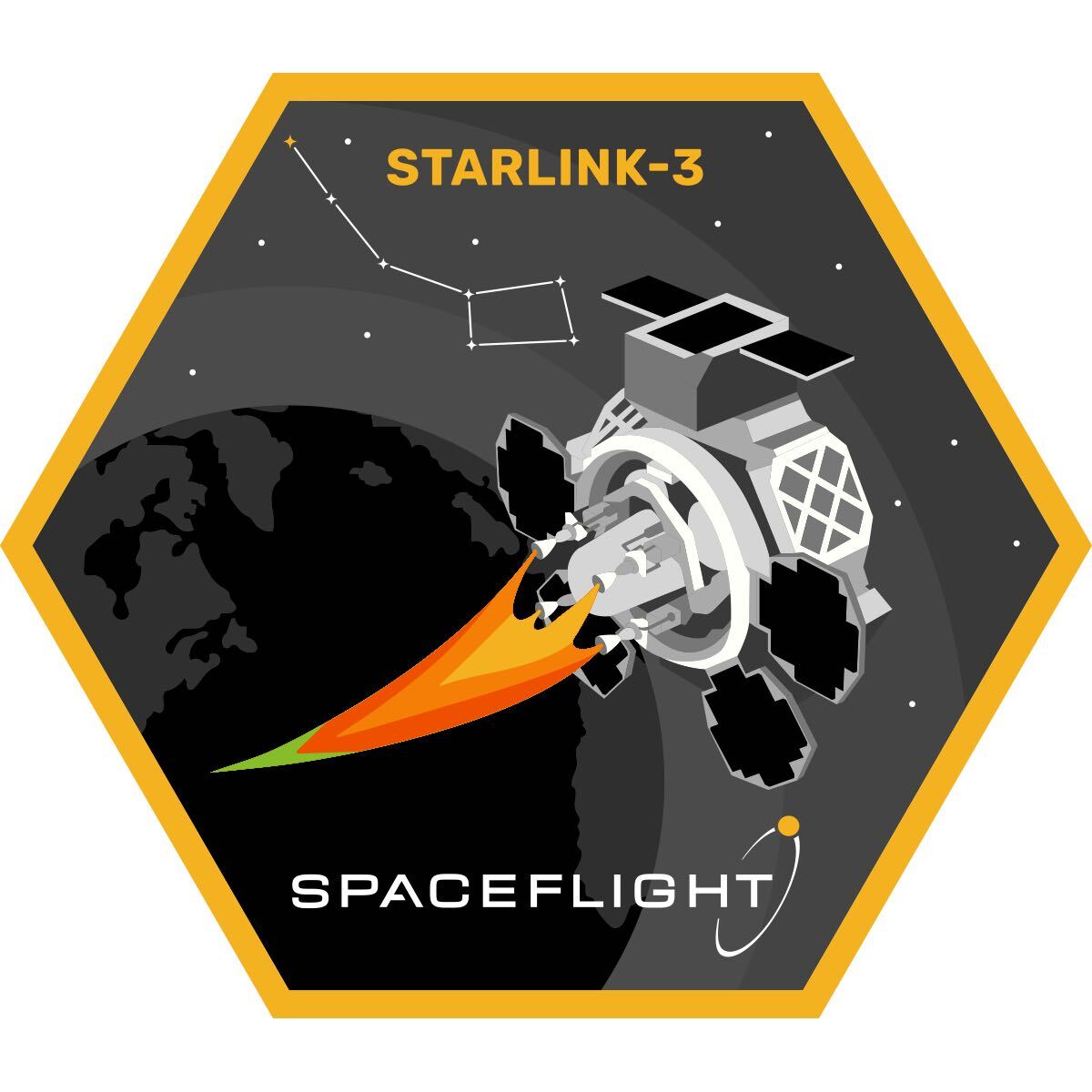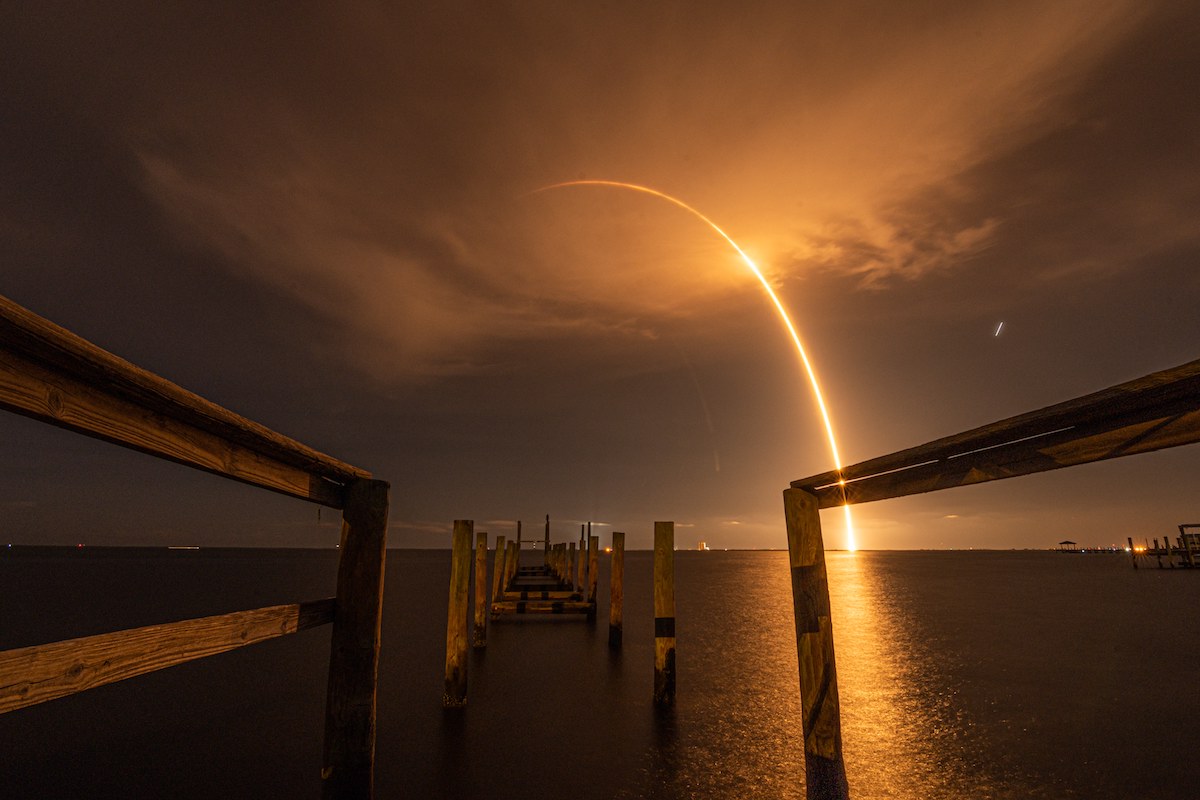6.09.2022

The mission patch for the Sherpa-LTC mission shows an illustration of the Spaceflight-built orbital transfer vehicle. Credit: Spaceflight
SpaceX launched a Falcon 9 rocket Sunday night with 51 more Starlink internet satellites and a rideshare payload that will use a Spaceflight-built orbital transfer vehicle to climb into a higher orbit to test broadband communications technology for Boeing.
Liftoff from Space Launch Complex 40 at Cape Canaveral Space Force Station aboard a Falcon 9 rocket occurred at 10:09:40 p.m. EDT Sunday (0209:40 GMT Monday), marking SpaceX’s 40th launch of the year.
There was an 80% chance of favorable weather for the launch opportunity Sunday night, according to the U.S. Space Force’s 45th Weather Squadron.
The main payload for Sunday night’s mission, designated Starlink 4-20, was the next batch of SpaceX’s Starlink internet satellites. The rocket lofted 51 flat-packed Starlink spacecraft, less than the number carried on a typical Starlink launch from Florida, to accommodate a rideshare payload.
The secondary passenger was the chemically-propelled Sherpa-LTC orbital transfer vehicle riding on the Starlink payload stack inside the Falcon 9’s payload fairing. Built by Spaceflight, a Seattle-based spacecraft developer and rideshare launch broker, the Sherpa-LTC orbital transfer vehicle is designed to ferry small satellites and hosted experiments to different altitudes and inclinations after an initial ride into orbit from a large rocket.

The Sherpa-LTC orbital transfer vehicle on the Starlink 4-20 mission carries Boeing’s Varuna Technology Demonstration Mission, or Varuna-TDM. The mission is designed to demonstrate technologies and perform in-orbit performance testing for a V-band communications system, a proposed 147-satellite constellation to provide broadband connectivity to commercial and U.S. government users.
The Varuna-TDM mission will provide prospective users of the broadband satellite constellation “an opportunity to evaluate the performance of V-band communications links and ascertain their attributes and acceptability for specific applications,” Boeing said.
The Falcon 9 rocket deployed the Sherpa-LTC transfer vehicle with the Varuna tech demo mission into a near-circular orbit at an average altitude of around 192 miles (310 kilometers) above Earth, and an inclination of 53.2 degrees to the equator.
The Sherpa-LTC deployed first about 49 minutes into the flight, followed by separation of the 51 Starlink satellites at T+plus 72 minutes.
Spaceflight’s solar-powered orbital transfer vehicle will perform a sequence of burns to reach a circular orbit round 620 miles (1,000 kilometers) above Earth, where the Varuna tech demo mission will get underway. The Varuna tech demo payload was designed and built by Astro Digital, which also provided the command and control system for the Sherpa-LTC orbital transfer vehicle.
The Sherpa-LTC vehicle uses a bipropellant, “green” or non-toxic propulsion system developed by Benchmark Space Systems.
“Sherpa-LTC’s transportation capabilities coupled with the reliability and consistency of Starlink missions create an ideal solution for the customer’s unique mission needs,” said Curt Blake, CEO and president of Spaceflight. “Our OTV eliminates the barriers that make it more challenging for spacecraft to access uncommon orbits in LEO and beyond. We’re eager to continue to provide innovative, cost-effective, and dependable in-space transportation services for our customers and partners like Astro Digital.”
With the Starlink 4-20 mission Sunday, SpaceX has launched 3,259 Starlink internet satellites, including prototypes and test units no longer in service. The launch Sunday night was the 59th SpaceX mission primarily dedicated to hauling Starlink internet satellites into orbit.
Stationed inside a launch control center just south of Cape Canaveral Space Force Station, SpaceX’s launch team began loading super-chilled, densified kerosene and liquid oxygen propellants into the 229-foot-tall (70-meter) Falcon 9 vehicle at T-minus 35 minutes.
Helium pressurant also flowed into the rocket in the last half-hour of the countdown. In the final seven minutes before liftoff, the Falcon 9’s Merlin main engines were thermally conditioned for flight through a procedure known as “chilldown.” The Falcon 9’s guidance and range safety system were also configured for launch.
After liftoff, the Falcon 9 rocket vectored its 1.7 million pounds of thrust — produced by nine Merlin engines — to steer northeast over the Atlantic Ocean.
The rocket exceeded the speed of sound in about one minute, then shut down its nine main engines two-and-a-half minutes after liftoff. The booster stage released from the Falcon 9’s upper stage, then fired pulses from cold gas control thrusters and extended titanium grid fins to help steer the vehicle back into the atmosphere.
Two braking burns slowed the rocket for landing on the drone ship “Just Read the Instructions” around 400 miles (650 kilometers) downrange approximately eight-and-a-half minutes after liftoff.
The first stage for Sunday’s launch is designated B1052 in SpaceX’s inventory. The booster made its seventh flight to space. This vehicle flew as a side booster on two Falcon Heavy rocket missions in 2019, then was converted to fly as a first stage on the Falcon 9 rocket, beginning earlier this year.
The Falcon 9’s reusable payload fairing jettisoned durning the second stage burn. A recovery ship was also on station in the Atlantic to retrieve the two halves of the nose cone after they splash down under parachutes.
Landing of the first stage on Sunday’s mission occurred moments after the Falcon 9’s second stage engine cut off to deliver the Starlink satellites into a preliminary transfer orbit orbit. A second burn of the upper stage about 45 minutes after launch placed the payloads into the proper orbit for separation.
After releasing the Sherpa-LTC payloads, the upper stage jettisoned retention rods from the Starlink payload stack, allowing the flat-packed satellites to fly free from the Falcon 9’s upper stage in orbit. The 51 spacecraft will unfurl solar arrays and run through automated activation steps, then use krypton-fueled ion engines to maneuver into their operational orbit.
The satellites will use on-board propulsion to do the rest of the work to reach a circular orbit 335 miles (540 kilometers) above Earth.
The Starlink satellites will fly in one of five orbital “shells” at different inclinations for SpaceX’s global internet network. After reaching their operational orbit, the satellites will enter commercial service and begin beaming broadband signals to consumers, who can purchase Starlink service and connect to the network with a SpaceX-supplied ground terminal.
ROCKET: Falcon 9 (B1052.7)
PAYLOAD: 51 Starlink satellites and Sherpa-LTC (Starlink 4-20)
LAUNCH SITE: SLC-40, Cape Canaveral Space Force Station, Florida
LAUNCH DATE: Sept. 4, 2022
LAUNCH TIME: 10:09:40 p.m. EDT (0209:40 GMT)
WEATHER FORECAST: 80% chance of acceptable weather; Low risk of upper level winds; Low risk of unfavorable conditions for booster recovery
BOOSTER RECOVERY: “Just Read the Instructions” drone ship east of Charleston, South Carolina
LAUNCH AZIMUTH: Northeast
TARGET ORBIT: 188 miles by 196 miles (304 kilometers by 316 kilometers), 53.2 degrees inclination
Quelle: SN
